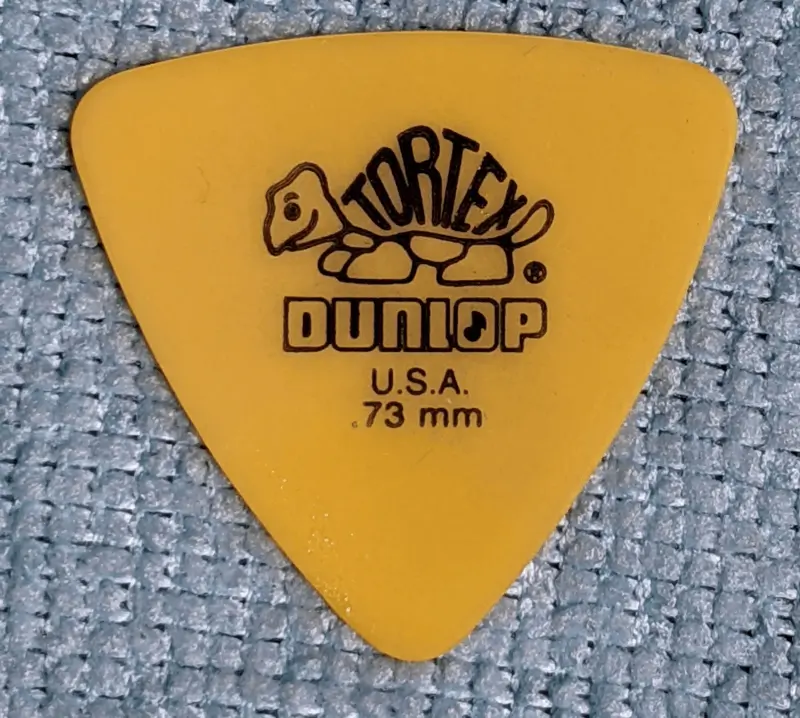It is the end of Summer (in New England that is) and a Summer Yellow one, the Dunlop Tortex Realeaux Yellow .73mm Plectrum:
Well, here we are, mere weeks from the end of New England’s Summer, how better to tribute the summer’s ensuing end with a pick colored like the morning sun: The Dunlop Tortex .73mm Yellow Reuleaux Pick!
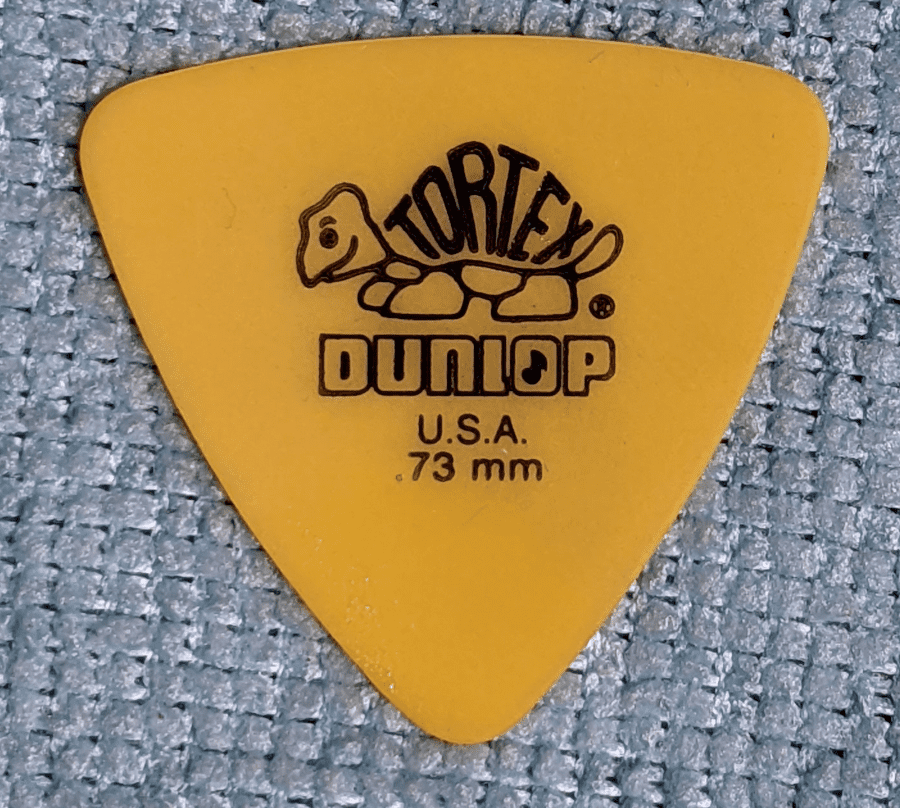
Sometimes when I’m writing, I wonder if I even have something worthy to say, and other times I can’t shut myself up.
Well, I know opinion motivates writing, and my brother-in-law’s opinion of this pick is much higher than some of the others I have…
He doesn’t work well with smallish picks, he’s got big hands and long fingers, and he is a guitarist that strikes his strings very firmly at this stage in his learning. He tends to like my larger Reuleaux picks, and would even love one that was bigger if it were thin and somewhat flexible. So far, no such pick seems to exist.
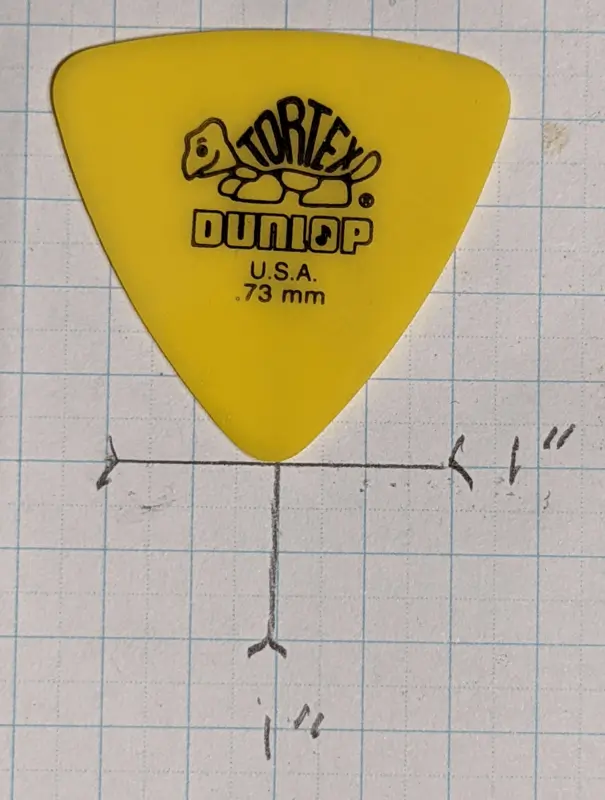
Dunlop picks selection here.
I like this pick also, I, my own self, am still working on my own grip. A pick I will be acquiring soon is supposed to solve one of my problems, so we will see how that works out in a few weeks.
For now, The Yellow Dunlop Pick on Graph Paper, Reuleaux .73 stays in my hands pretty darned well and has a lightly chalky texture.
It has a matte surface from the Tortex with the “Tortex turtle logo”. I think Dunlop wants us to expect that these picks are a close solution to what older guitarists complain about:
Picks today are not the same as Tortoiseshells. What I have to say about Tortoiseshells is that I got one by accident and honestly, I can live without it. This is the 2020’s for Heaven’s sake. Yes, animal materials can make good picks, but we have to balance our quest against not destroying the balance of our world.
Is Tortex like Tortoise?
Who’s to say? Is it as good as it is? I think it is, or rather, it is good enough. Maybe, in all honesty, it’s better. Tortoiseshell breaks easily, after all, and this pick gets reviews that indicate people find them durable.
Speaking of “good enough”:
I’m a former engineering technologist and one lesson that was hard won in college was learning that “good enough” is a true, realistic goal, to be good enough. During my first months in college, I was obsessed with perfection and refused to turn in lab reports. A classmate took me aside and gave me a good lecture. She already had a Master’s in business and was our top theory student.
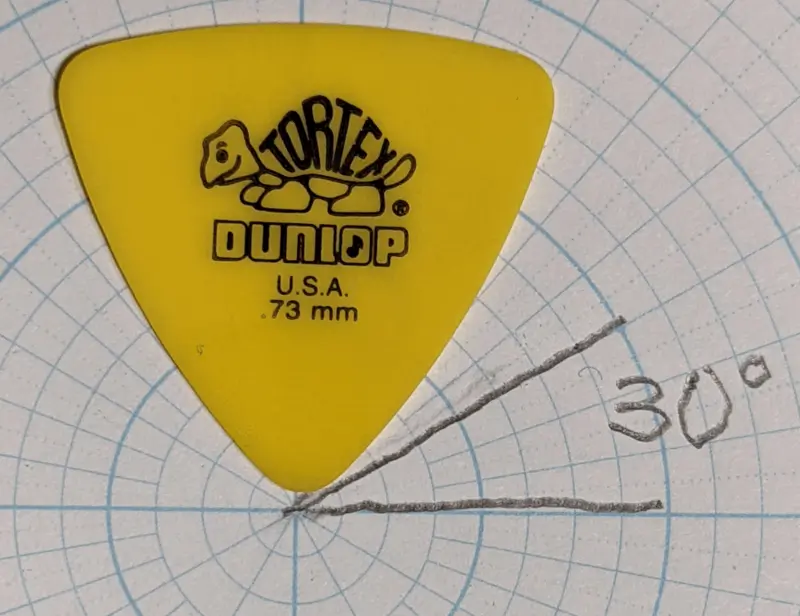
After her talk with me, one where she told me that my current report would theoretically get me, not one A, but TWO A’s. That “shook me up to the core”. She showed me my classmate’s labs and she told me that everyone believed I was the best lab student, so why was I self-destructing with perfectionism? I kept turning things in way too late and agonizing over them.
Now I agonize over picks and guitars and gear, but it’s fun. Science is fun too, but it can be highly stressful if you didn’t know…
I’m a firm believer, now, that no pick needs to be perfect, it simply needs to be good enough for whatever use it will see. The Tortex picks are indeed good enough, more than good enough. And no, I don’t think there will ever be a perfect pick.
Yes, huge advances are happening, some I will talk about soon, but do we really think anything in music should be “perfect”? Look at what Auto-tune has done to music, it turned it into crap. At least that is my opinion and I’m not alone!
Still, iterative efforts to get closer and closer to something fantastic are to be applauded and supported.
Dunlop came along when all we had was Celluloid. Yes, Celluloid is damned good, good enough for more than half the players out there even. But my site is as much about the quest for something different and just maybe something better. The raison d’etre of questing for continued self-improvement and advancement keeps us going as guitarists, after all, right?
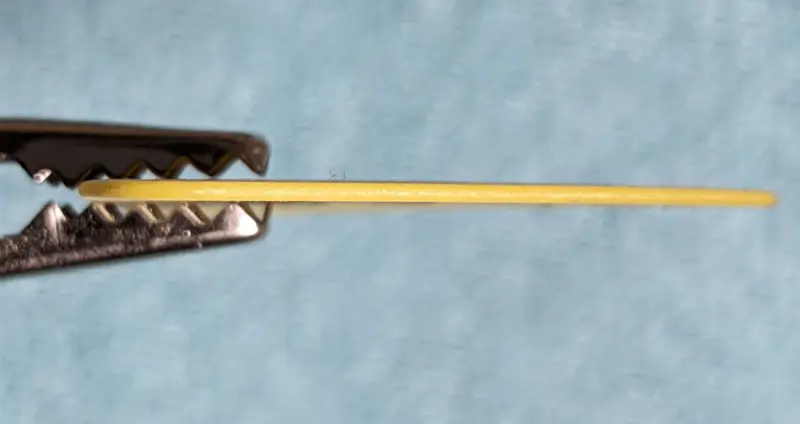
When a guitarist plateaus she or he loses purpose.
Nothing more needs to be said, so perfection is not the goal, not with this yellow pick and not with your (or my) playing.
But back to the pick: It grips darned well considering it is a very flat pick. This is partly because it is a nice big Realaux shape. Some of you will find a wider pick like this difficult, but novices will love it. Those of you playing mandolin or other certain instruments will love this. This would sound great on a 12 string jumbo flattop.
It also has more flex than some even more modern materials, and many of us need some flex when playing certain things. Most of us pick AND strum, so we generally look for some flex, and this has a “just right” amount for much of what one would do.
So it’s time for the specs on The Yellow Dunlop Pick on Graph Paper, Realeaux .73:
| Material | Attack Tone | Decay Tone |
Dunlop’s Tortex | Firm but “easy” | a touch of scrape, but warm |
| Durability/Wear | Comments/Dimensions | Shape |
| Said to be pretty durable, but pros do wear them down | Durometer 66.5H hardness, relatively soft | A Realeaux Triangle |
| Grip and Feel | Flexibility | Likely Use |
Modestly good grip, textured feel | Decent flex moderate but still firm | Mandolin, picking with strumming and stops |
| Thickness | Width and Height | Resonance |
.73mm | 32mm all around | mellow & plastic-y |
| Tip Style | Bevel? | Approx. Cost |
| rounded but finer tip | None, too thin | $4+ for 6 |
The tone is a touch brighter than celluloid and almost flappy (though not quite) like light celluloid.
I would also assert that this material seems pretty durable, more so than some other Dunlop picks and certainly more than some celluloid. The tip is almost but not quite abrupt but still rounded. I tend to prefer this over a sharp-tipped pick, I don’t know about the rest of you, but at this stage in my playing, it’s great. Pointy picks are great for speed pickers with more experience than me. As I grow, I get more used to pointy picks, but I still prefer a more rounded tip at this point.
I think the “give” in this pick, the “grip” in this pick, and the “tone” in this pick are good enough, which for most of us, is “perfect”. But still, it’s just a pick, right?
And this pick won’t obviate all the reasons for others, it’s just, well, “just right” for what it is intended for. Everyone should try a Tortex, pick your shape!
Now, in our next review, speaking of perfection, diamonds can be almost perfect, and this next pick is from the stuff of diamonds…
I want to ask YOU now: What shapes of picks do you like? What have you tried? Should manufacturers bring back the no longer made Celluloid shapes from yesteryear?

